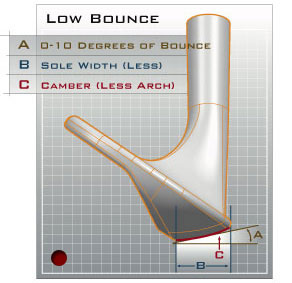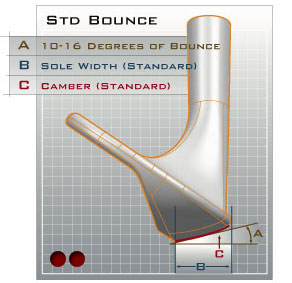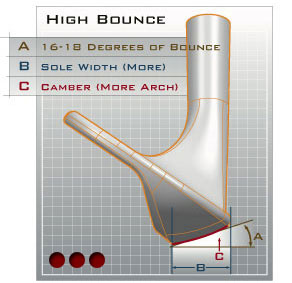What is custom fitting?
Everyone's golf swing is different so it makes sense to adjust golf clubs to suit the individual.
Custom fitting is the process for tailoring a golf club to suit your personal swing. Effectively golf club manufacturer's know that a set of clubs aren't cheap so the least they could do is make them fit.
Whatever your level, the aim is to ensure that if you do make a good swing, the club will be square at impact and should produce a straight shot.
Will it fix my slice?
 |
It can help. If you slice the ball it means that the toe of the club is leading into the ball which opens the face of the club.
That may be down to a swing fault, but it could be because the club is too flat. So as part of the custom fitting process you can make the club more upright to help with this.
This will mean that the toe of the club will be slightly off the ground at address to compensate.
What do you need to bring with you for a fitting session?
Rather than bringing down your old clubs it might be better to start from scratch. It's a big misconception that custom fitting is only for good golfers. Anyone can benefit.
That said, if you plan to upgrade a new set of clubs with the same manufacturer they may be able to adjust your old set.
In the end all you need is an open mind.
What difference will custom fitting make?

Computer details calculate your swing efficiency
|
Custom fitting won't cure all your bad shots. Coaching will sort that out. But if you do make a good swing, then the club will arrive correctly at impact and should produce a straight shot at your target.
That alone will save shots during a round.
How much does it cost?
We offer free custom fitting with most of our golf clubs.
If you wish to book an appointment to get fitted to your current golf clubs, a full session costs £45 and lasts approx 2 hours.
Please contact us for further details.
What does 'Bounce Angle' refer to?
Most golfers understand that wedges differ by loft - typically from a 45 degree pitching wedge up to as high as 64 degrees for the most extremely lofted lob wedge. But what about the bounce angle? As the name implies, the 'bounce' (in layman's terms, the curvy bit on the sole of the wedge) enables the head to 'bounce' out of the sand or rough without snagging. On a sand wedge, for example, you'll see that the trailing edge hangs below the leading edge. Take a club and put in the address position and you’ll see a space between the ground and the leading edge of the wedge. High space = High Bounce angle.
The most bounce you'll ever see on a wedge is about 18 degrees - but it can be as low as 2. Using a wedge with the right combination of bounce and loft for the sort of course you play and the sort of swing you have can make a big difference to your short game. So how do you decide what’s best? Here’s a quick guide:
Low Bounce Wedges
 Low Bounce Wedges are ideal for shots from tight lies and firm turf conditions. The combination of less bounce and narrower sole-width lowers the leading edge of the blade to promote a clean contact. Perfect for players who like to be creative around the greens and in the bunkers and who have shallow attack angles through impact. Less bounce and narrower sole width make it easier to open the face and hit high, soft landing flop shots. Low bounce wedges are typically in the lower loft range – eg pitching and gap wedges which are used for longer approach shots. A lot of bounce would be undesirable because it would make it more difficult to get the leading edge under the ball, causing you to ‘thin’ it.
Low Bounce Wedges are ideal for shots from tight lies and firm turf conditions. The combination of less bounce and narrower sole-width lowers the leading edge of the blade to promote a clean contact. Perfect for players who like to be creative around the greens and in the bunkers and who have shallow attack angles through impact. Less bounce and narrower sole width make it easier to open the face and hit high, soft landing flop shots. Low bounce wedges are typically in the lower loft range – eg pitching and gap wedges which are used for longer approach shots. A lot of bounce would be undesirable because it would make it more difficult to get the leading edge under the ball, causing you to ‘thin’ it.
Golfers who strike down at a sharp angle can put a lot of back spin on the ball – and may benefit using wedges with very little bounce (less than 8 degrees), but they are a minority of golfers. As a rule, most golfers are better off with more bounce (10 to 14 degrees), not less.
Standard Bounce Wedges
 Standard Bounce is the best all-around wedge for playability in all types of conditions for all types of players. It is very versatile for players who like to be creative around the greens. The Standard Bounce is also an excellent choice for players who like to play an open or square face out of the bunker, and who have an average to slightly steeper attack angle.
Standard Bounce is the best all-around wedge for playability in all types of conditions for all types of players. It is very versatile for players who like to be creative around the greens. The Standard Bounce is also an excellent choice for players who like to play an open or square face out of the bunker, and who have an average to slightly steeper attack angle.
High Bounce Wedges
 High Bounce wedges are designed for play out of soft turf and sand. The combination of the wider flange and higher bounce angle prevent digging and create a smoother gliding action of the sole along the ground. Works exceptionally well out of (soft) sand for players who prefer to keep a square face through impact. High Bounce wedges are also a good choice for players with steep attack angles.
High Bounce wedges are designed for play out of soft turf and sand. The combination of the wider flange and higher bounce angle prevent digging and create a smoother gliding action of the sole along the ground. Works exceptionally well out of (soft) sand for players who prefer to keep a square face through impact. High Bounce wedges are also a good choice for players with steep attack angles.
High bounce wedges tend to be associated with higher lofts – but this certainly isn’t always the case. For example, lob wedges (60-64 degree) which throw the ball very high for soft-landing ‘pop-up’ shots around the green (Phil Mickelson’s speciality) tend to have low bounce because even the smallest error can make the club ‘bounce’ off the ground and cause a ‘thinned’ shot. You know the sort well – instead of gently throwing the ball 10 feet in the air and plopping it by the pin – it travels at warp speed a few inches above the ground, lodging deep into thick bushes 50 yards behind the green. Lob wedges tend to have less sole width and a sharp leading edge.